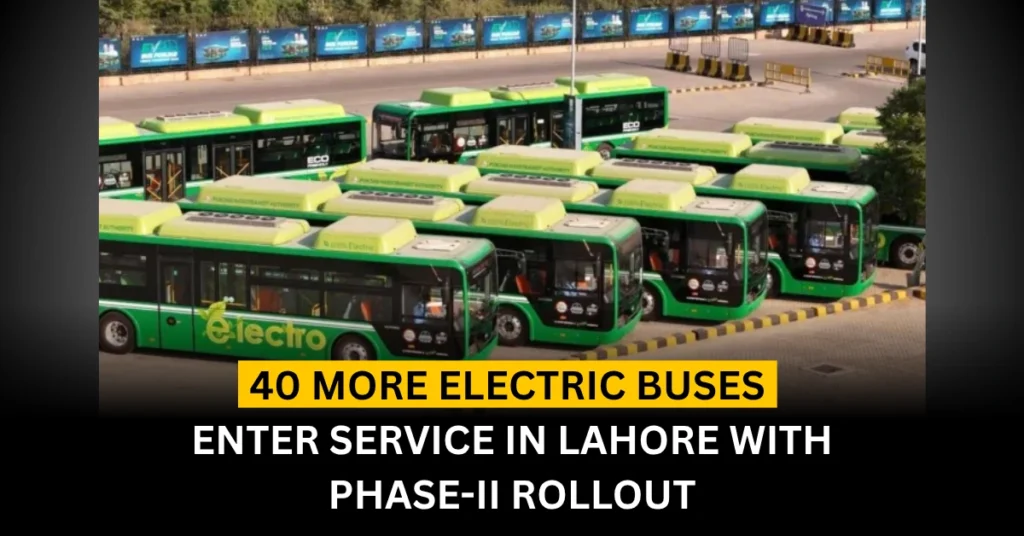The government of Punjab has taken another step toward greener urban mobility by introducing 40 more electric buses in Lahore under the Phase-II rollout of its sustainable transport program. This milestone comes after the successful launch of the first fleet earlier in 2025, further establishing Lahore as a pioneer in electric mass transit in Pakistan. The initiative is part of a broader vision to reduce pollution, modernize public transport, and make commuting more affordable for citizens.
Expansion Plan
Chief Minister Punjab inaugurated the new buses, announcing that 70 additional electric buses will be added by December 2025, bringing the total close to 500 in the coming phases. This expansion reflects the government’s commitment to electrifying urban transport and reducing dependency on diesel vehicles. By scaling up the fleet, Lahore is not only enhancing capacity but also addressing traffic congestion and long-term environmental concerns. Importantly, the service will also expand to Nankana Sahib, Kasur, and Sheikhupura, connecting more districts with eco-friendly transportation.
Also Read
Changan Launches Karvaan Power Comfort 1.2L in Pakistan at Rs. 3.15 Million
Routes and Services
The newly launched buses are operating on two important routes:
- Raiwind → Jinnah Terminal (Thokar Niaz Baig)
- Jinnah Terminal (Thokar Niaz Baig) → Harbanspura
These routes were chosen because they connect residential areas with major transit hubs, making them vital for students, office workers, and daily commuters. By providing low-cost and reliable transport on these high-demand routes, the project is expected to significantly reduce reliance on private vehicles and traditional minibuses. This also helps reduce traffic congestion and lowers fuel consumption across the city.
Features and Amenities
The electric buses in Lahore are equipped with modern facilities designed to improve passenger comfort and safety. Free Wi-Fi ensures that students and professionals can stay connected on the go, while CCTV cameras improve security for all passengers. Mobile charging ports allow commuters to keep their devices powered during travel, and wheelchair ramps make the buses accessible to people with disabilities.
Another major highlight is the ultra-low fare of Rs. 20, which is among the cheapest in the region for air-conditioned transport. To encourage inclusivity, the government has allowed students, senior citizens, and differently-abled individuals to ride free, making this service a socially supportive initiative in addition to being environmentally friendly.
Technical Specifications of Yutong E12PRO
| Feature | Details |
|---|---|
| Model | Yutong E12 / E12PRO (12m Electric Bus) |
| Battery Capacity | 350 – 423 kWh (LFP, liquid-cooled) |
| Passenger Capacity | ~70 (with 30–39 seats) |
| Range | ~300 km per charge (real-world conditions) |
| Charging | DC fast charging (150–300 kW, CCS2 standard) |
| Special Features | Yutong safety system, Wi-Fi, CCTV, ramps |
These specifications show that the buses are designed for long daily duty cycles, ensuring they can operate efficiently on Lahore’s busy routes. Fast charging allows them to be ready for service with minimal downtime, while their battery size supports extended ranges suitable for city travel.
Environmental Benefits
Each electric bus in Lahore helps cut around 10–20 tonnes of CO₂ annually compared to a conventional diesel bus. With 40 buses now active, this means over 400 tonnes of CO₂ emissions avoided every year. In addition to reducing greenhouse gases, these buses also lower noise pollution and particulate matter, both of which are serious health concerns in Lahore’s urban environment.
The government’s plan to introduce 500 buses in the long term would lead to thousands of tonnes of CO₂ savings annually, making it one of the most impactful green transport programs in Pakistan.
Join our WhatsApp channel. For more related news,
Challenges and Future Outlook
While the electric bus project is a significant achievement, it faces several challenges:
- Charging infrastructure: High-capacity chargers (up to 300 kW) are needed across depots and key terminals to support the growing fleet.
- Grid reliability: Lahore’s electricity demand is already high, and integrating large fleets of electric buses will require stable grid connections and possibly on-site storage solutions.
- Maintenance and training: Technicians need specialized training to handle high-voltage systems, battery diagnostics, and preventive maintenance.
- Financial sustainability: With ultra-low fares, the project depends on subsidies to remain viable in the long run. Careful planning is needed to balance affordability with operational costs.
Despite these challenges, the outlook is positive. With international support, private partnerships, and government commitment, Lahore is well-positioned to expand its green transport fleet.
Conclusion
The rollout of 40 new electric buses in Lahore marks a historic step in sustainable mobility, offering cleaner air, affordable travel, and modern facilities to thousands of commuters. With the government’s plan to scale up to 500 electric buses across Punjab, this project has the potential to redefine public transport in Pakistan, reduce reliance on fossil fuels, and set an example for other South Asian cities aiming for greener futures.


